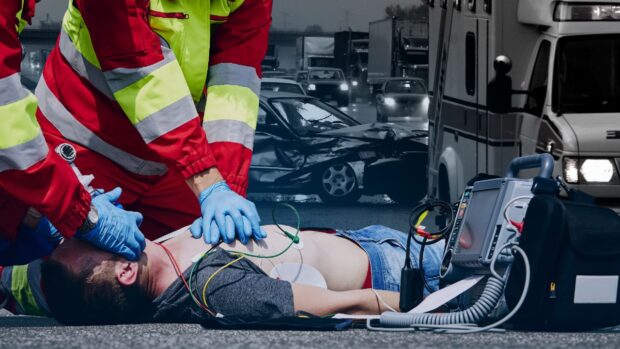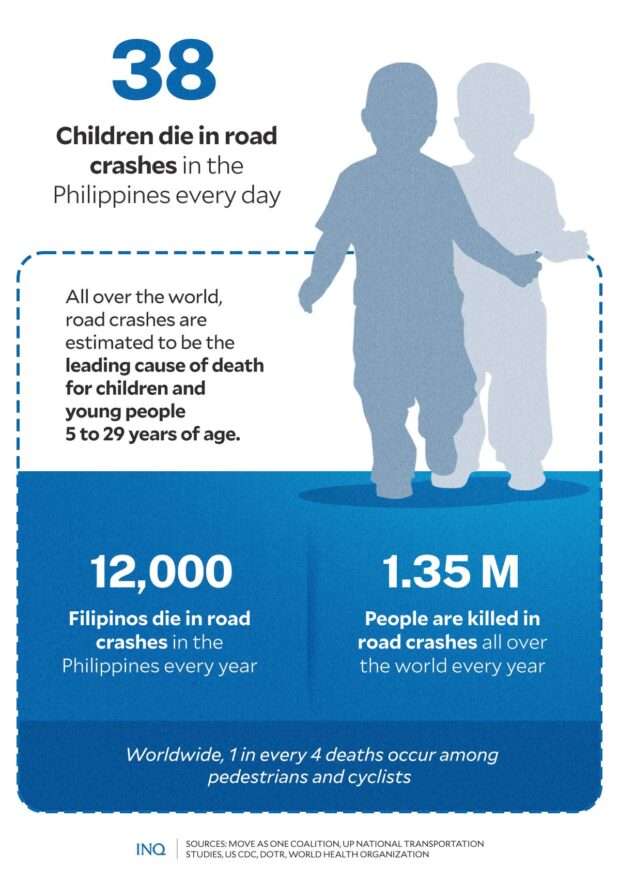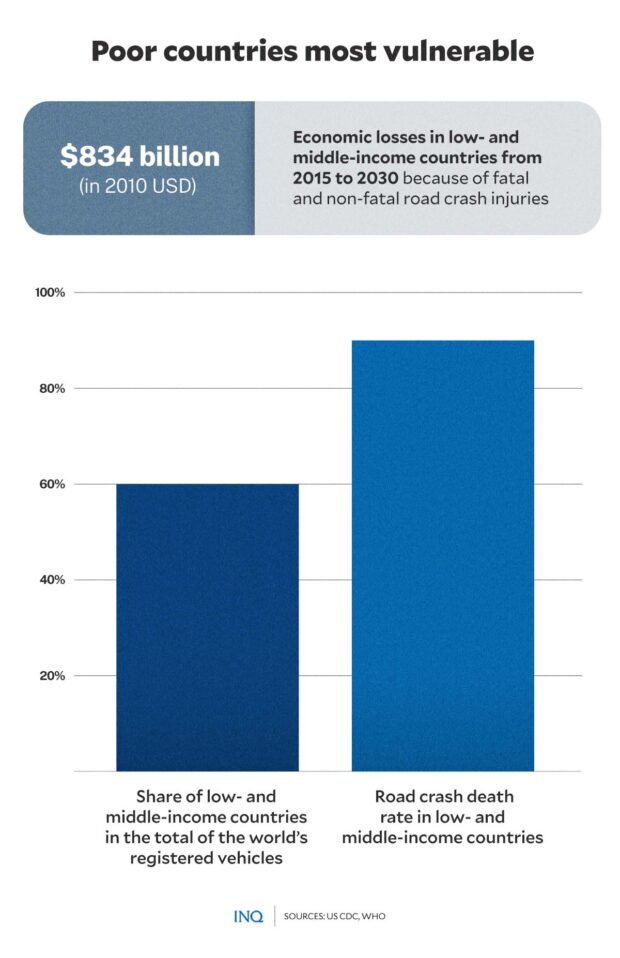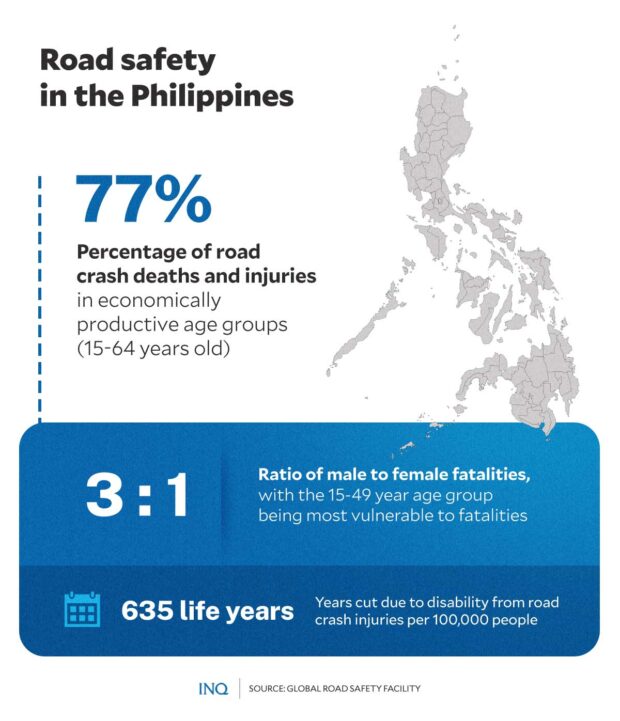38 PH kids die each day in road crashes
MANILA, Philippines—While it’s hard to believe that almost 40 children die in road crashes in the Philippines every day, the Move As One Coalition stressed that it was the “heartbreaking” reality.
Last Tuesday (May 16), the coalition posted a question on Facebook in time for the observance of the 7th United Nations (UN) Road Safety Week. “How many children die in a road crash in the Philippines every day?” it asked.
The next day, citing the findings of the University of the Philippines-National Center for Transportation Studies, it said “it breaks our heart to tell you that 38 kids die in road crashes daily.”
READ: Gov’t urged to make streets safer for kids
“That’s 38 deaths too many,” the Move As One Coalition said, stressing that “we should be outraged—and unite in stopping the murder of children on our roads”: “Let’s all #ArriveAlive.”
As it said, “the death of even a single child in a preventable road crash is enough cause for outrage,” pointing out that while there is a lot more to be done to gather accurate and comprehensive data, “what is clear is that zero lives is the only acceptable number.”
Last year, the Department of Transportation (DOTr) revealed that road crashes kill 12,000 Filipinos every year, with Transport Secretary Jaime Bautista saying that “we see a significant increase in road crash deaths and injuries.”
RELATED STORY: Metro Manila vehicle crashes averaging 156 daily
This, he said, “could have been prevented with proper road safety enforcement.”
World’s problem
All over the world, millions die in road crashes yearly, making it the leading cause of death for children and young people 5 to 29 years of age. It is the eighth leading cause of death for all age groups.
Based on the latest data from the World Health Organization (WHO) and the United States Centers for Disease Control and Prevention (US CDC), every year, 1.35 million people are killed in road crashes.
Every day, almost 3,700 lives are ended in crashes involving cars, buses, motorcycles, bicycles, trucks, or pedestrians and that more than half of the victims are pedestrians, motorcyclists, or cyclists.
READ: LTO sounds alarm after 15 killed to road accidents due to drunk driving in 2022
WHO said one in every four victims is pedestrian and cyclist.
According to the US CDC, “more people now die in [road] crashes than from HIV/AIDS (Human Immunodeficiency Virus/Acquired Immunodeficiency Syndrome).”
It said the road crash death rate is over three times higher in low- and middle-income countries (LMICs) than in high income countries at 93 percent even though they only account for 60 percent of the world’s registered vehicles.
Likewise, the US CDC stated that road crash injuries place a huge economic burden on LMICs as it is estimated that they will suffer about $834 billion (in 2010 USD) in economic losses from 2015 to 2030 because of fatal and non-fatal road crash injuries.
It is estimated, too, that fatal and non-fatal road crash injuries will cost the world economy about $1.8 trillion (in 2010 USD) over the same period. This, it said, is equivalent to a yearly tax of 0.2 percent on worldwide gross domestic product.
RELATED STORY: Our deadly roads
WHO said fatal and non-fatal road crash injuries “cause considerable economic losses to individuals, their families, and to nations as a whole.”
“These losses arise from the cost of treatment as well as lost productivity for those killed or disabled by their injuries, and for family members who need to take time off work or school to care for the injured,” it said.
As the US CDC stressed, there was no reduction in the number of deaths in any low-income country from 2013 to 2016, based on WHO’s Global Status Report on Road Safety in 2018.
Dream of safer roads in PH
Bautista had said the DOTr “adheres to its solid commitment to promoting and raising everyone’s awareness of the importance of road safety,” stressing that they will continue to implement initiatives based on the agency’s Philippine Road Safety Action Plan.
READ: DOTr seeks multisectoral approach to road crashes
According to the World Bank’s Global Road Safety Facility (GRSF), the DOTr is the Philippines’ lead agency in efforts to reduce road crash deaths through coordination, legislation, monitoring and evaluation of road safety strategies.
This, as the GRSF revealed in its profile for the Philippines that 77 percent of all road crash deaths and injuries are in the economically productive age groups of 15 to 64 years old.
It said 3:1 is the ratio of male to female deaths, with the 15 to 49 age group being the most vulnerable to deadly road crashes. Likewise, 635 life years are cut because of disability from road crash injuries for every 100,000 people.
The Philippines’ Permanent Mission to the UN had said “it is our goal to create a universal transportation ecosystem that caters to the needs and safety of all road users, especially for people with limited mobility, children and other vulnerable groups”
“The Philippines has been advancing this objective through the Philippine Road Safety Action Plan 2017-2022, which is a comprehensive and inclusive plan that adopted a vision of zero road traffic death, with an interim target to reduce the road death rate by at least 20 percent by 2022.”
Safety hints
The US CDC said road crashes, which are already a public health concern, are preventable, stressing that whether one is a driver, passenger, cyclist, or pedestrian, safety should be always kept in mind.
- Overspeeding
As pointed out by the WHO, an increase in average speed is directly related both to the likelihood of a crash occurring and to the severity of the consequences of the crash, explaining that every 1 percent increase in mean speed produces a 4 percent increase in the fatal crash risk and a 3 percent increase in the serious crash risk.
- Drink- and drug-driving
Driving while in the influence of alcohol and any psychoactive substance or drug increases the risk of a crash that results in death or serious injuries, as stressed by the WHO.
It said in the case of drink-driving, the risk of a road traffic crash starts at low levels of blood alcohol concentration and increases significantly when the driver’s BAC is ≥ 0.04 grams/deciliter.
Then in the case of drug-driving, the WHO pointed out that the risk of incurring a road traffic crash is increased by vartibg degrees depending on the kind of psychoactive drug used.
- Non-use of motorcycle helmets, seat-belts, and child restraints
It was stated that correct helmet use can lead to a 42 percent reduction in the risk of deadly injuries and a 69 percent reduction in the risk of head injuries, while the use of seatbelt reduces the risk of death by 45 to 50 percent among drivers and front seat occupants and 25 percent among rear seat occupants.
The use of child restraints, meanwhile, can lead to a 60 percent reduction in deaths, the WHO said.
- Distracted driving
There are many types of distractions that can lead to impaired driving, the WHO said, however, the distraction caused by mobile phones is already a growing concern for road safety.
It pointed out that drivers using mobile phones are approximately four times more likely to be involved in a crash than drivers not using a mobile phone.
This, as it explained that using a mobile phone while driving slows reaction times, like braking reaction time, and makes it difficult to keep in the correct lane, and to keep the correct following distances.
- Unsafe road infrastructure
The design of roads can have a considerable impact on their safety, the WHO said, stressing that “ideally, roads should be designed keeping in mind the safety of all road users.”
This would mean making sure that there are adequate facilities for pedestrians, cyclists, and motorcyclists. Measures such as footpaths, cycling lanes, safe crossing points, and other traffic calming measures can be critical to reducing the risk of injury among these road users, it said.
- Unsafe vehicles
WHO said safe vehicles play a critical role in averting crashes and reducing the likelihood of serious injury. There are a number of UN regulations on vehicle safety that, if applied to countries’ manufacturing and production standards, would potentially save many lives.
- Inadequate post-crash care
Delays in detecting and providing care for those involved in a road traffic crash increase the severity of injuries.
“Care of injuries after a crash has occurred is extremely time-sensitive: delays of minutes can make the difference between life and death. Improving post-crash care requires ensuring access to timely prehospital care, and improving the quality of both prehospital and hospital care, such as through specialist training programmes,” the WHO said.
- Inadequate law enforcement of traffic laws
It was stressed that if traffic laws are not enforced or are perceived as not being enforced, it is likely they will not be complied with and therefore will lead to very little chance of influencing behavior.
“Effective enforcement includes establishing, regularly updating, and enforcing laws at the national, municipal, and local levels that address the above mentioned risk factors. It also includes the definition of appropriate penalties.”
READ: Road safety may be included in K-12 curriculum next year
TSB



